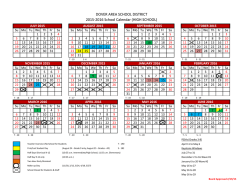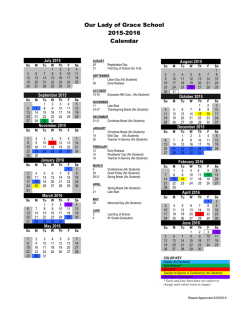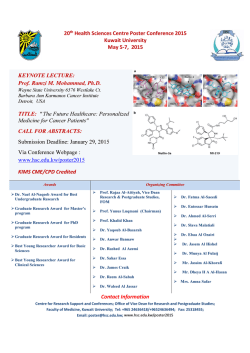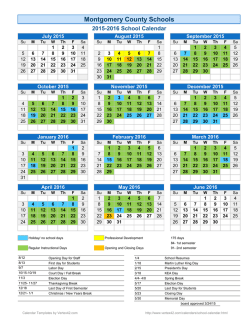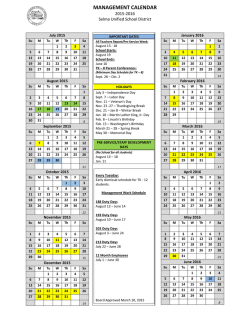
2016 Innovator LOI guidelines FINAL_100715
LETTER OF INTENT GUIDELINES 2016 CURE Innovator Award – Request for Applications (RFA) The CURE Innovator Award supports the exploration of a highly innovative, often risky new concept or untested theory that addresses an important problem relevant to epilepsy. The Innovator Award proposed research must reflect ideas substantially different from those being pursued by anyone in the epilepsy research field. The program is not intended to support the logical progression of an already established research project but, instead, allows Principal Investigators (PIs) the opportunity to pursue radically unconventional, paradigm-‐shifting hypotheses. This award mechanism supports high-‐risk studies that have the potential to reveal entirely new areas of epilepsy research. Research completed through an Innovator Award must provide sufficient preliminary data to enable the PI to prove or disprove their groundbreaking, original, and/or unconventional hypothesis and have the potential, if the scope of work is successful, to move epilepsy research forward by leaps rather than by incremental steps. Innovator Award applications will be evaluated based on: • • • • Importance of the problem Novelty and innovation of the hypothesis and/or proposed methodology Magnitude of the potential impact of the work Logic of the experimental plan and likelihood of some success (some non-‐zero number) Preliminary data is not necessary to receive this grant but may be included. Areas of Interest: This program awards seed grants to researchers submitting innovative proposals that will provide new directions for epilepsy disease modifying therapies, prevention and, ultimately, a cure. We specifically encourage studies that may not be currently fundable by other agencies or other mechanisms because of their preliminary, innovative or unconventional nature. Eligibility: This award is available to both established and early career investigators*. Researchers who serve on CURE’s Scientific Advisory Council are ineligible to apply for or sponsor a grant for the duration of their term. International applicants are welcome. All materials must be submitted in English. * Generally, early career investigators are university faculty at the assistant professor level (or hold an equivalent position in a non-‐university research organization). Established investigators are university faculty at the associate professor level or above. Post-‐doctoral fellows may not apply for this award. Budget: Requests may be made for up to $50,000 for one year. Indirect costs are not supported. CURE Innovator Award LOI Guidelines -‐page 1-‐ 2016 FUNDING CYCLES Letter of Intent Deadline Full Application Invitations Full Application Deadline Anticipated Award Announcement Anticipated Project Start Date Cycle 1 November 19, 2015 – 9pm ET by January 5, 2016 February 17, 2016 – 9pm ET May 2016 June 2016 Cycle 2 March 16, 2016 – 9pm ET by May 4, 2016 June 15, 2016 – 9pm ET September 2016 October 2016 Letter of Intent: All applicants must submit a Letter of Intent (LOI) via our online application portal proposalCENTRAL (https://proposalcentral.altum.com). In order to begin an application, applicants will need to create a proposalCENTRAL professional profile, if one does not already exist. Please fill in all required fields in the online application form (instructions below). Instructions for each section of the online application: 1) Title Page: Enter proposal title (maximum 150 characters, including spaces). 2) Download Instructions: Download additional copies of these guidelines if needed. 3) Enable Other Users to Access this Proposal: Use this optional section to grant access to a collaborator or co-‐investigator. 4) Applicant/PI: This section should auto-‐populate from the applicant’s professional profile. Double-‐check that the information is complete and correct. If it is not, click Edit Professional Profile to update the information. Indicate whether you are an early career or established investigator. 5) Institution & Contacts: Information should auto-‐populate from the applicant’s profile. 6) Collaborators: Please enter information for any co-‐investigators or collaborators, if applicable. 7) Keywords: Add at least 3 keywords that highlight topics found in your research proposal. 8) Current and Pending Support: List all current and pending support for you and any co-‐ investigators. 9) Attach LOI (Letter of Intent): Once the LOI is finalized per the instructions below, attach by uploading the PDF into this section of proposalCENTRAL. 10) Validate: The system will check for required components that have not been completed. Applicants will not be able to submit until all required fields are completely filled out. 11) Submit: Make sure to hit Submit after your application has been validated! Letter of Intent Instructions: In your uploaded letter of intent, please provide the following: 1) Lay Summary: Your LOI will be reviewed by members of CURE’s Lay Review Council. Using non-‐ scientific language (1/2 page maximum), please provide the following: a. Project Goals: Bulleted list of the goal(s) of the project. b. Aims: Bulleted list of how those goals will be tested. CURE Innovator Award LOI Guidelines -‐page 2-‐ c. Deliverables: Bulleted list of tangible deliverables to result from this work if the aims are successful. d. Impact: Briefly explain how this project, if the aims are successful, will transform the field of epilepsy and contribute to improved treatment and prevention. 2) Scientific Summary: Clearly and succinctly outline the hypothesis and specific aims, and provide a brief description of how the proposed research plan aligns with CURE’s mission, with the above stated goals of the Innovator Award category, and with CURE’s desire to boldly push epilepsy research forward by leaps rather than by incremental steps (1 page maximum). LOIs are evaluated by scientific reviewers and the CURE Lay Review Council for the following six criteria: innovation, feasibility, scientific merit, relevance to CURE’s mission, relevance to CURE’s priority areas, and potential to be transformative for people with epilepsy. Please briefly consider these six evaluation criteria in your LOI. Note: All genetic data generated with CURE funding is required to be deposited in CURE’s Epilepsy Genetics Initiative (EGI) database.. Formatting Guidelines: • Type font: 12 point, 10 pitch • Type density: No more than 15 characters per inch (including spaces). For proportional spacing, the average for any representative section of text should not exceed either 15 characters per inch or 114 characters per line. • Spacing: Single-‐spaced between lines of text, no more than five lines of type within a vertical inch. • Margins: Minimum of 0.5-‐inch top, bottom, right, and 1-‐inch left. Inquiries: Questions regarding these guidelines are welcome and should be directed to Liz Higgins at [email protected] or 312-‐255-‐1801. CURE Innovator Award LOI Guidelines -‐page 3-‐
© Copyright 2026

